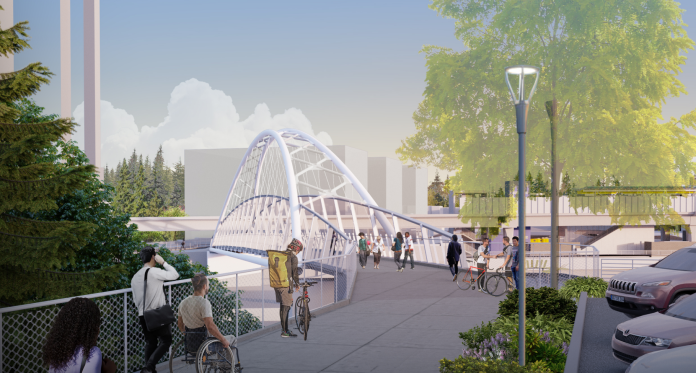
Shoreline has been awarded a $20 million grant that will significantly aid the City’s efforts to improve transportation access to Shoreline South light rail station. The grant, awarded as part of the Rebuilding American Infrastructure with Sustainability and Equity (RAISE) program, will allow the city to fully fund its planned bike and pedestrian bridge directly connecting transit riders on the west side of the highway with the light rail station, and providing a route across south Shoreline for everyone. Delays in funding the bridge mean that it isn’t expected to open until 2026, approximately two years after light rail trains begin serving the station just east of I-5 at NE 148th Street.
The award was announced by US Senators Patty Murray and Maria Cantwell late last week, ahead of an official announcement by the federal Department of Transportation (USDOT), which administers the grants, expected later this week.
“Shoreline is constantly growing — and supporting this effort has been a longtime priority of mine, so I am really excited for Sound Transit to open its newest Link light rail station,” Murray said in a statement announcing Washington’s total RAISE grant awards, which total almost $133 million. “We have to make sure that pedestrians, cyclists, and people using wheelchairs can safely access the new station, and this grant will go a long way towards making that happen.”
The $20 million awarded is $5 million less than Shoreline had requested from USDOT when it applied for the grant earlier this year, so the City may have to look to some additional funding sources to fill in that gap, but the grant gets Shoreline nearly all the way there on fully funding a suite of projects around NE 148th Street station. The City was already planning to provide a local match of $7.7 million, according to the grant application, submitted this February.
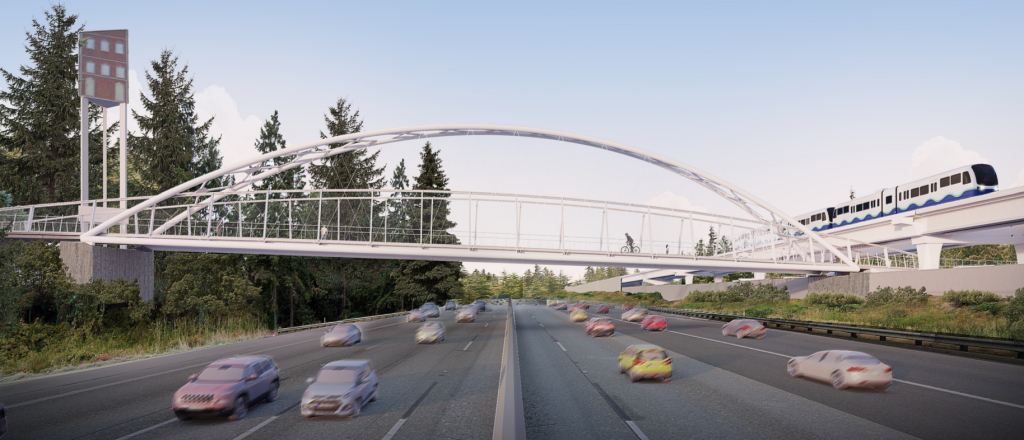
In addition to the I-5 pedestrian bridge, funds from the grant will aid in Shoreline’s goal of expanding the 145th Street corridor, also known as State Route 523, between I-5 and the Interurban Trail, just west of Aurora Avenue North. Property acquisition along the first phase of that project, between I-5 and Corliss Ave North, has already begun.
That project is expanding the state highway to make room for a new center turn lane on the street, with an expanded planter strip along the Shoreline side of the street to provide a buffer from traffic for pedestrians. At I-5, that work is happening in conjunction with a project that will add roundabouts to both sides of I-5 to increase vehicle throughput and hopefully improve safety.
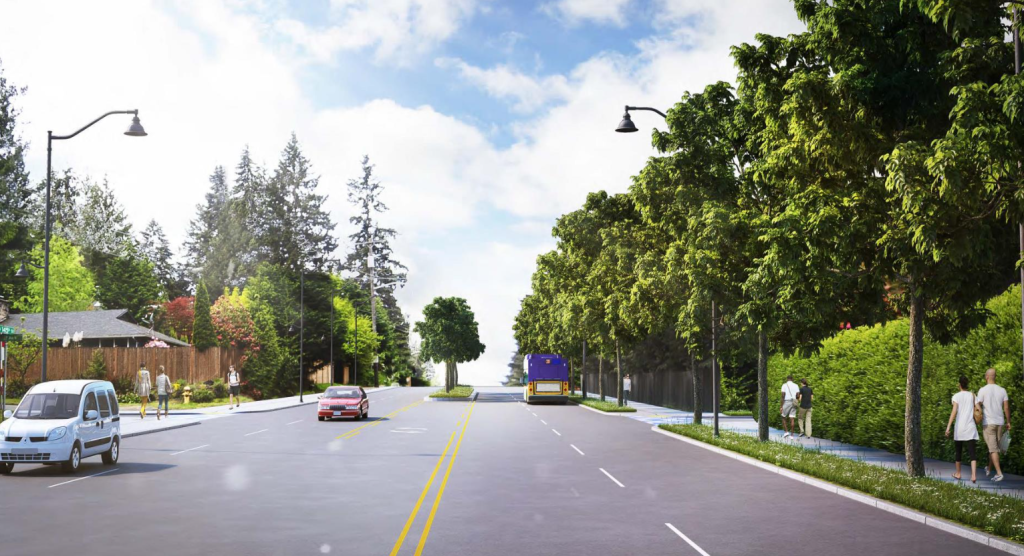
Despite plans to widen 145th, space for safe bike facilities isn’t being made on the street, which is where a planned “off-corridor bike network” comes in, taking the form of neighborhood greenways connecting the Interurban Trail, the I-5 bridge, and bike routes south in Seattle. Collectively, all of these projects around the light rail station are being called the “West Side Transformation,” with the goal of making it easier to get around in an area with 4,000 new units of housing either open or in permitting or construction, with the potential to accommodate 20,000 new households in the area around the station longer-term.
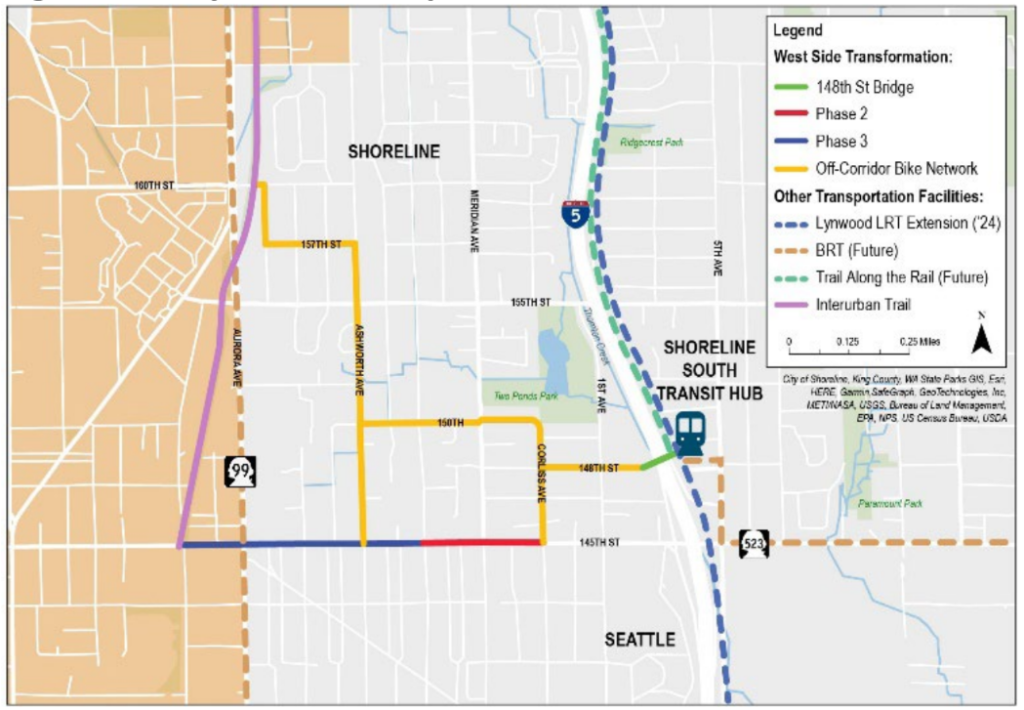
Shoreline Mayor Keith Scully called the grant a “game changer” for the city. “[The grant] will allow us to complete our vision for the 145th Corridor, creating safe, reliable multimodal connections to the Shoreline South/148th light rail station,” he said in a statement released by Senator Cantwell’s office.
In March, when Representative Pramila Jayapal visited the site of the future bridge after securing an additional $4 million to fill the outstanding funding gap in this year’s federal budget, her delegation drove from one side of I-5 to the other, illustrating the hostility of the pedestrian pathway on NE 145th Street as it stands today. “Few venture down the roadway on bicycle or walking as the 5-foot sidewalks are punctuated by utility poles and signage stating, ‘WALKWAY NOT ACCESSIBLE FOR WHEELCHAIR USE.’ The lack of Americans with Disabilities Act (ADA) accessible curb ramps further limit use for this very vulnerable population,” Shoreline’s application for the RAISE grant noted.
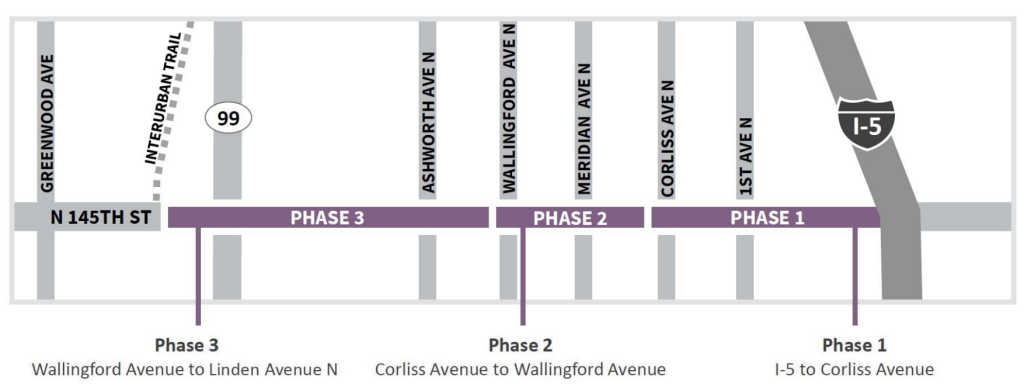
The application also cited heavy congestion on the corridor as a reason that transit agencies have “largely avoided” providing service on 145th Street between I-5 and Aurora Avenue North. Currently, King County Metro proposes adding a new Route 46 as part of a area-wide bus restructure timed with the opening of the Lynnwood Link light rail extension in 2024: that 46 bus will run between Northgate Station and NE 148th Street, serving Haller Lake and the growing residential district on the west side of I-5 in Shoreline. To date, there are no plans to give this bus its own dedicated lane on the newly remade street.
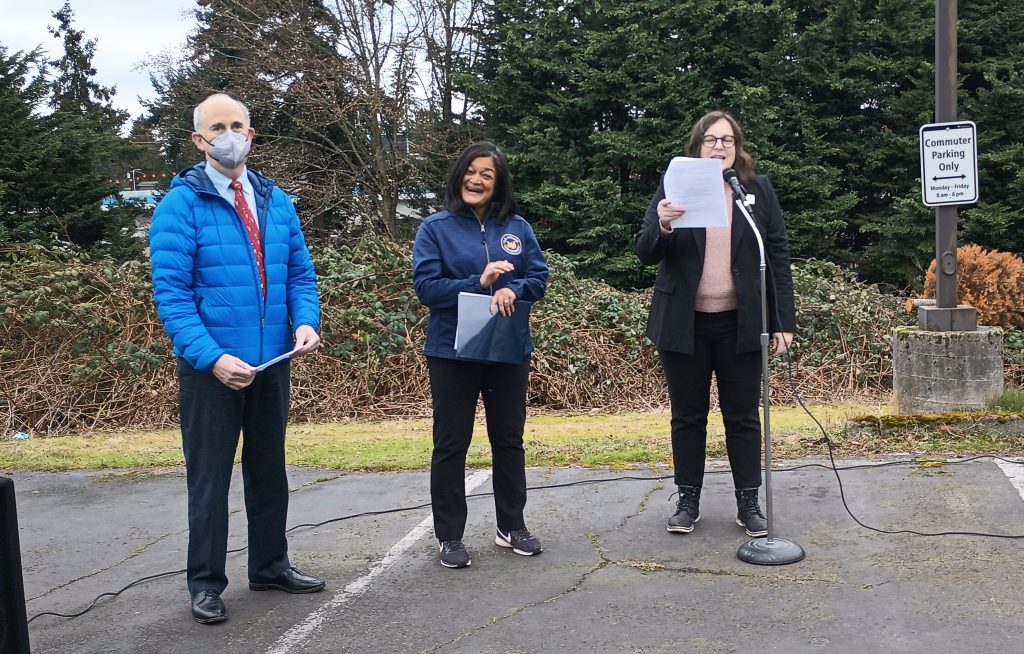
When they submitted the application back in February, Shoreline city officials were optimistic about their chances of winning the grant, based on last year’s successes for nearby Bothell and Lynnwood, both mid-sized cities that previously had been at a bit of a disadvantage when it comes to securing grant funds in the past. But an expanded amount of funds available thanks to 2021’s Investment in Infrastructure and Jobs Act (IIJA), and a concerted effort by USDOT to focus on cities of Shoreline’s size, greatly increased the likelihood of success this year. In addition, some big players in the region, including Seattle, Bellevue, and the Washington State Department of Transportation’s central Puget Sound division, passed on requesting RAISE grant funds for any capital projects this year.
Shoreline’s significant award will advance a number of the city’s goals around improving access to light rail and other sustainable transportation infrastructure all at once, and represents a major accomplishment for Seattle’s neighbor to the north.
Ryan Packer has been writing for The Urbanist since 2015, and currently reports full-time as Contributing Editor. Their beats are transportation, land use, public space, traffic safety, and obscure community meetings. Packer has also reported for other regional outlets including BikePortland, Seattle Met, and PubliCola. They live in the Capitol Hill neighborhood of Seattle.

